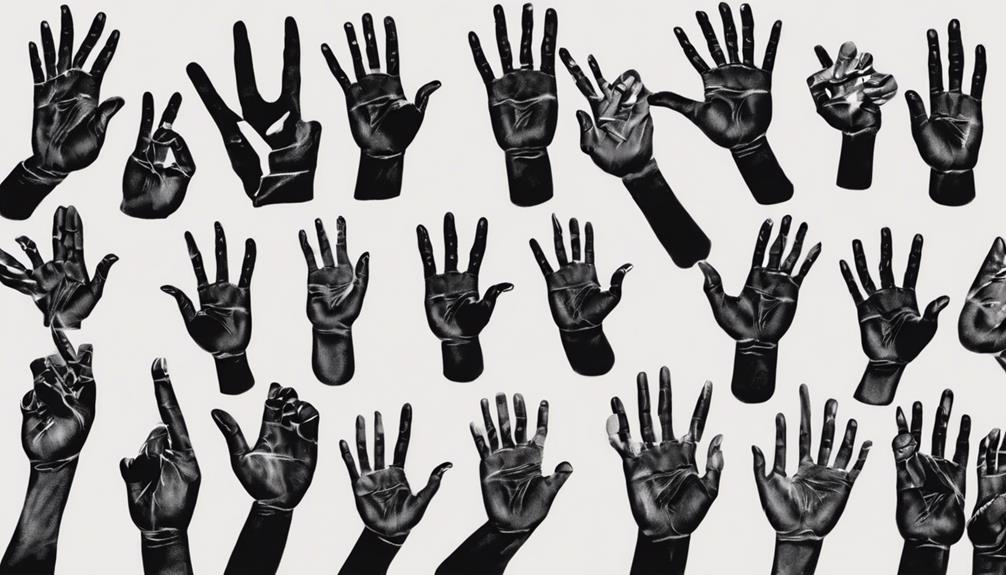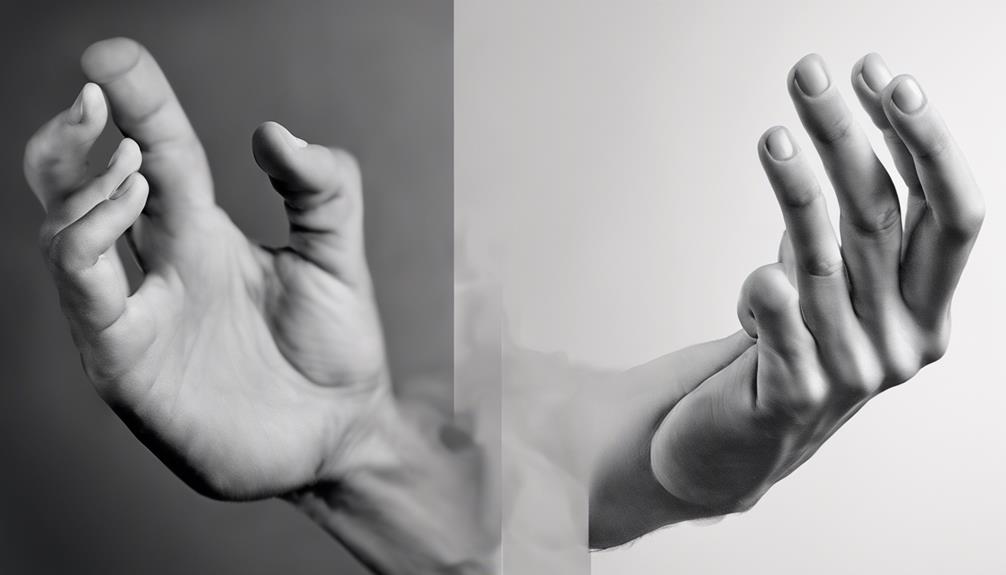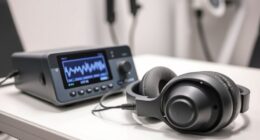In the world of sign language communication, there is a key phrase that is commonly used as a standard greeting.
To convey 'How Are You' fluently, the subtle yet impactful hand movements play a crucial role.
The way the signs are crafted and the accompanying facial expressions can truly enhance the message being conveyed.
But there's more depth to this simple phrase that might pique your curiosity and lead you to explore further nuances of sign language communication.
Key Takeaways
- Using hand gestures for 'how' and 'you' conveys 'how are you'
- Facial expressions and body language enhance ASL communication
- Practice and repetition improve signing fluency
- Cultural considerations show respect and foster inclusivity
Basic Introduction to Sign Language
Learning the basic principles of sign language is crucial for effective communication with Deaf and hard of hearing individuals. American Sign Language (ASL) is a visual-gestural language that serves as a primary mode of communication for the Deaf community. By taking the time to learn how to sign, we can bridge communication barriers and foster inclusivity. ASL involves a combination of handshapes, movements, and facial expressions to convey meaning. Understanding and using sign language, even at a basic level, can greatly enhance interactions with Deaf individuals.
Mastering sign language greetings like 'how are you' can significantly improve social interactions. By incorporating sign language into our communication repertoire, we demonstrate respect and consideration for the Deaf community. Regular practice of sign language not only enhances our communication skills but also strengthens connections with Deaf individuals. Embracing sign language as a form of communication promotes accessibility and inclusivity in various social settings. Learning to sign is an invaluable skill that can positively impact our interactions with the Deaf community.
Hand Gestures for 'How Are You

To sign 'How Are You' in American Sign Language, make a fist with both hands, thumbs up, and roll your hands forward for 'how,' then point at the person to indicate 'you.' This gesture combines the signs for 'how' and 'you' to convey the question 'how are you' or 'how are you doing.'
Practice signing 'how are you' by rolling your fingers forward and pointing towards the individual you're addressing. This sign is commonly used to greet someone in sign language, showing that you're interested in their well-being.
By mastering these hand gestures, you can effectively communicate and connect with individuals who use American Sign Language as their primary form of communication. Remember to maintain eye contact and approach the interaction with warmth and openness to create a positive and inclusive environment.
Sign language provides a beautiful way to bridge communication barriers and show care and respect for others.
Facial Expressions and Body Language
Facial expressions play a vital role in sign language communication by conveying tone and emotions, enhancing the overall message being signed.
When using sign language, facial expressions work in harmony with body language, including posture and hand movements, to provide crucial context and meaning.
The intensity of facial expressions and body language can completely alter the message being conveyed, underscoring the importance of their proper use.
By mastering the nuances of facial expressions and body language in signing, individuals can express themselves more effectively and accurately, leading to clearer and more meaningful communication.
Understanding how to synchronize facial expressions and body language with signs is essential for sign language users to ensure their messages are conveyed accurately and comprehensively.
Therefore, honing these skills through practice and attention to detail is key to becoming proficient in sign language communication.
Practice and Repetition for Mastery

Moving from understanding the nuances of facial expressions and body language in sign language, we now shift our focus towards mastering the sign language expression 'how are you' through consistent practice and repetition. To improve fluency and proficiency, it is essential to practice signing 'how are you' by repeating the hand movements for 'how' and 'you'. Repetition plays a crucial role in effectively mastering this sign language expression. Consistent practice with the signs for 'how' and 'you' will not only enhance your comfort level but also make you more confident in using them during conversations. Focus on the hand shapes and movements when practicing 'how are you' to ensure accurate and clear signing. Regular practice sessions dedicated to refining these signs will boost your confidence and overall competency in signing 'how are you' in ASL.
| Practice Tips | Benefits |
|---|---|
| Repeat hand movements | Improve fluency and proficiency |
| Consistent practice | Enhance comfort and confidence |
| Focus on hand shapes | Ensure accurate and clear signing |
| Regular practice sessions | Boost confidence and competency |
Cultural Considerations and Etiquette
Considering the cultural nuances and etiquette when signing 'how are you' in sign language is essential for fostering respectful and inclusive interactions within the Deaf community.
In Deaf culture, asking 'how are you' isn't just a formality but a meaningful way to show respect and concern for someone's well-being. By using sign language for this greeting, one demonstrates an understanding and appreciation for the Deaf community's language and communication preferences.
Non-verbal cues and facial expressions are significant in conveying the sincerity and warmth behind the sign for 'how are you' in American Sign Language (ASL).
Learning the appropriate sign for 'how are you' showcases an individual's willingness to break communication barriers and encourage inclusivity in interactions with Deaf individuals.
Understanding the cultural significance of signing 'how are you' helps nurture positive relationships and mutual understanding between hearing and Deaf individuals, creating a more harmonious and respectful environment for all.
Frequently Asked Questions
What Is the ASL Sign for How Are You?
We know the ASL sign for 'how are you' involves rolling our fists with thumbs up and pointing to the person we're addressing. This combination is commonly used in ASL as a greeting to ask about someone's well-being.
It's important for effective communication with Deaf individuals. Practice rolling your fists forward and pointing to ask about their condition.
Mastering this sign allows us to engage meaningfully with others who use sign language.
How Do You Say Hey How Are You Doing in Sign Language?
We can sign 'hey, how are you doing?' in American Sign Language (ASL) by combining the signs for 'hey,' 'how,' 'you,' and 'doing' in sequence.
First, wave your hand for 'hey,' then roll your hands forward for 'how,' point at the person for 'you,' and mimic an activity for 'doing.'
Practicing this sequence reinforces ASL vocabulary and fluency. Incorporating facial expressions and body language enhances the effectiveness of conveying this greeting in ASL.
How Do You Ask Someone How They Are in Sign Language?
We ask someone how they're in sign language by combining signs for 'how' and 'you' in a fluid motion. This common greeting in American Sign Language promotes inclusivity and communication with the deaf community.
Incorporating sign language in our daily interactions enhances our signing skills and strengthens connections with those who are deaf or hard of hearing.
Let's continue to practice and use sign language to better engage with others and foster understanding.
Is There a Sign for How in Asl?
Yes, there's a sign for 'how' in ASL. It involves placing fists together, thumbs up, and rolling hands forward. This versatile sign allows for inquiring about various conditions or manners.
Learning this sign can enhance communication skills in sign language. Practicing it can boost fluency and confidence in conversing through ASL.
Mastering the sign for 'how' opens doors to effective communication and engagement in sign language conversations.
Conclusion
In mastering the sign for 'how are you', remember that communication goes beyond just words. Sign language allows for rich expression through gestures, facial expressions, and body language.
By practicing and incorporating these elements into your interactions, you can enhance your ability to connect with others on a deeper level. Embrace the beauty of sign language as a unique form of communication that transcends cultural boundaries and fosters understanding.











